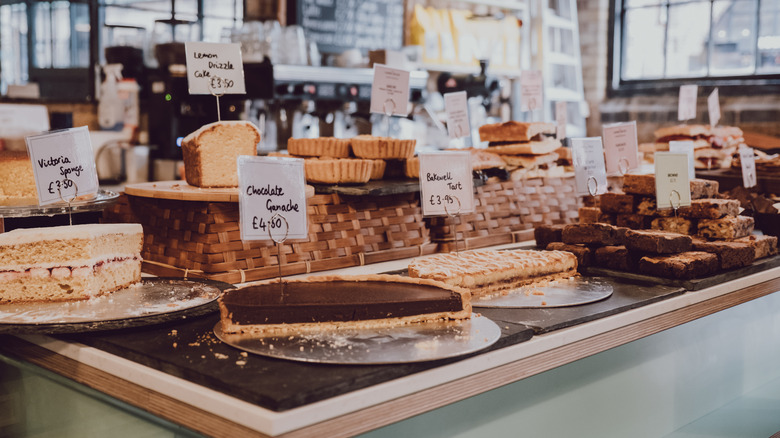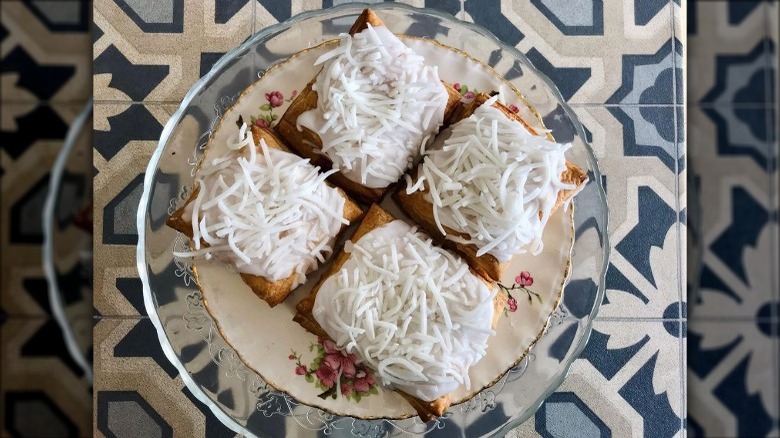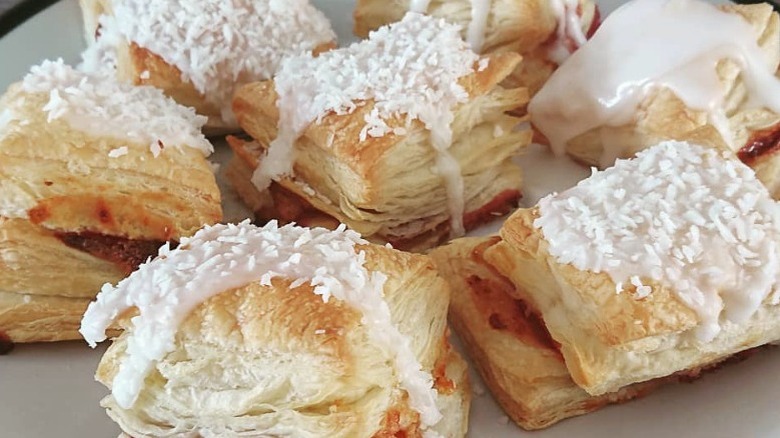London Cheesecake Isn't What It Sounds Like At All
When we mention London cheesecake, does your mouth immediately begin to water at the thought of biting into a velvety blend of vanilla, cream cheese, and graham cracker crust? Well, we're sorry to disappoint. But as it turns out, London cheesecakes are delicious sweets that basically have nothing to do with the creamy, velvety treat most people are familiar with. (Fun fact: Cheesecakes aren't technically cakes, either.)
Instead, this unique creation shares similarities with another classic English dessert that you might recognize from "The Great British Bake Off" called a Bakewell tart, which hails from the eponymous town in Derbyshire. Both start with pâte feuilletée dough (Bakewells can also be made with shortcrust) that is piped with jam and rich almond cream and then baked. The two desserts are distinct in several ways, but a major deviation is that Bakewell tarts are open-faced and typically topped with almonds, whereas London cheesecake — which almost looks like a fruit turnover — receives a generous sprinkling of shredded coconut for a different kind of decadent nuttiness.
With so many layers of flavors and textures, London cheesecakes are an easy sell for anybody with a sweet tooth. However, it's pretty clear that they aren't cheesecakes at all. So what's with the name? While the title of this tasty treat has little to do with its appeal, there's an easy explanation for its origins. Here's what to know about London cheesecake and what makes it worth seeking out (especially during tea time).
London cheesecakes are puffy pastries
Let's start with what London cheesecakes aren't. They aren't traditional cheesecakes and don't contain any cheese. They aren't even cakes, and while it might seem like we're joking at this point, it's also unclear whether they originated in London or not.
Instead, London cheesecakes are British baked goods packed with flavor. The base for these treats is puff pastry that is filled with creamy frangipane and a glob of sweet, fruity jam. The crackly puff pastry gives the dessert a wonderful flaky texture, while the almond cream adds nutty and sweet notes. The jam cuts through the almond cream's richness, providing a flavorful burst of tartness.
But the hint of tropical coconut might be the most important ingredient. It's this topping that sets the baked good apart from other jam-and-cream-filled pastries. It's also potentially how London cheesecake got its unique, misleading name. After baking to golden perfection, the pastries are brushed with a simple glaze made from icing sugar and water. They're then dipped into the dried coconut shreds, giving them the look of grated cheese.
The history of London cheesecake
While the dessert first became popular in the 1950s or 1960s, it's seemingly impossible to say where London cheesecake got its name. However, there are a few obvious reasons why one might refer to the puffy pastry as a cheesecake (which was, without the "London" added, its original name ... as if it needed to be more confusing).
For one thing, there's the aforementioned visual cue of the shredded coconut looking like grated cheese. And as noted by Village Bakers, a small chain of bakeries based in the South London town of Sutton, another possible origin story asserts that they actually did contain dairy in the form of curd cheese, though this remains debatable.
Village Bakers swears that its London cheesecake recipe does not, in fact, contain any cheese or curd but adds that you might see them called "Hairy Cheesecakes" or even "Hairy Marys," depending on where you get the delicacies and who you're ordering from.
The true origins of the pastry may be shrouded in mystery, but that hasn't prevented it from becoming a treasured dessert still enjoyed to this day. You'll find London cheesecakes in bakeries around the United Kingdom these days, making them the perfect tea-time treat for those interested in an afternoon sugar rush to balance out their brew.


